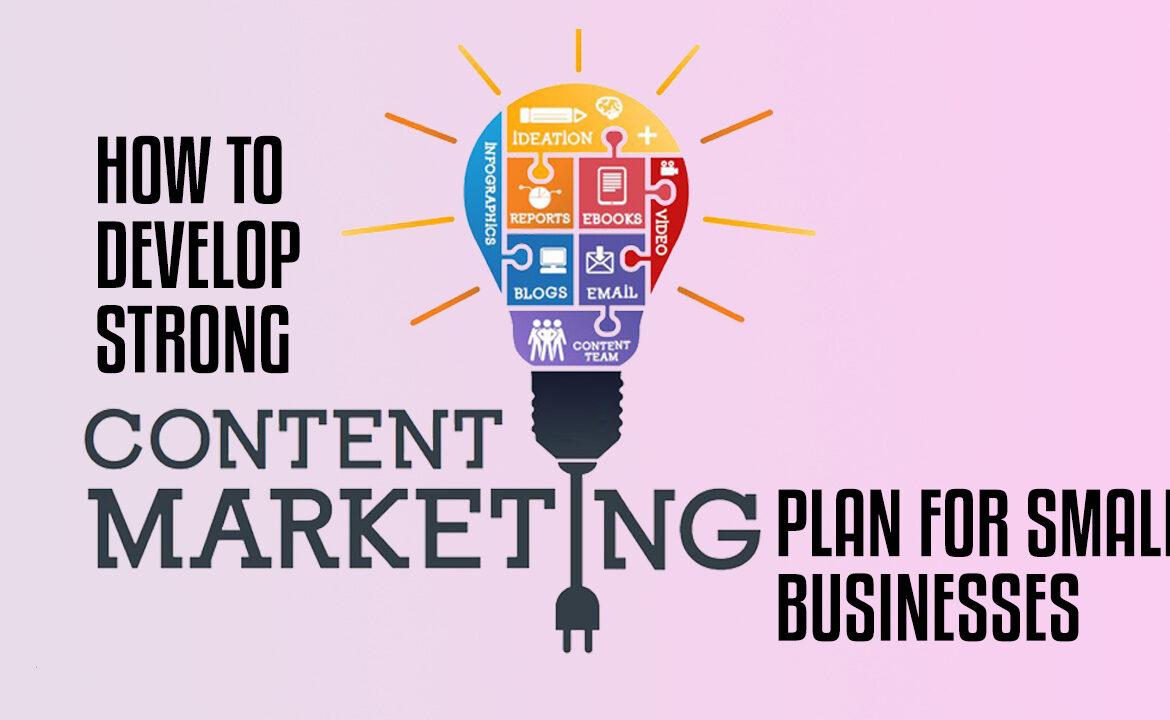Strong Content Marketing Plan
Do you want to create a strong content marketing plan for your small business, but don’t know where to start? This guide will walk you through the basics of creating and implementing a content marketing strategy that fits your budget and busy schedule.
We’ll cover everything from setting goals to creating content that engages your audience. Let’s get started!

Steps to Develop Strong Content Marketing Plan
If you’re a small business, creating a strong content marketing plan may seem like a daunting task. But don’t worry – it’s easier than you think. Here are some steps that help you get started:
1. Know your audience.

Your audience is the most important part of your content marketing strategy. When you know what they’re interested in and what kind of content they want to see, you can create content that speaks directly to them. This will help you attract more readers, and it will also help you build trust and credibility with them.
The first step in any content marketing plan is understanding your audience.
- Who are you trying to reach with your content?
- What are their interests and needs?
Once you know who your audience is, you can start creating content that appeals to them.
You may use this to get a better sense of your target audience’s demographics, demands, desires, pain spots, and even routines. Once you’ve got a good idea of your target audience, create a buyer persona.

Here’s an example. You’re marketing a Marketing Strategy Solution, and your target audience consists of the following traits:
- Located in: UK
- Category: Startup Business owners
- Age between: 25 and 50
- Need: To stay ahead in the market competition
Plan your posts as per the audience requirements by giving insights into the problems they are facing and your honest unique solution to help them. for example, here winning the market competition.
2. Determine your goals.

What do you want to achieve with your content marketing? Do you want to increase website traffic, generate leads, or boost brand awareness? Having clear goals will help you determine what type of content to create and how often to publish it.
Get creative and think outside the box – there are many ways to create valuable content. You don’t have to do it all yourself; team up with other businesses in your industry, or hire a freelance writer or marketing agency. But whatever route you take, make sure you track results
Here are some tips to get you started. First, think about your goals and what you want to achieve with your content marketing.
- Do you want to drive more traffic to your website?
- Boost sales?
- Deepen customer relationships?
Once you know what you’re aiming for, come up with a content strategy that aligns with your goals and target audience.
3. Create a content calendar.

A content calendar will help you plan and organize your content. It will also help you stay on track and ensure that you’re publishing content regularly. Once you know what type of content you want to create, you need to plan out when you’re going to create it.
This means setting a schedule and sticking to it. Block out time each week to work on your content marketing plan, and make sure to allocate time for research, writing, editing, and publishing.
i. content calendar benefits
It can help you map out your content ideas, plan and track your publishing schedule, and measure the success of your content marketing efforts.
The benefits of using a content calendar include:
- More effective content marketing: Planning your content makes it easier to produce quality content consistently.
- Easier organization and management of content: A content calendar helps you keep track of all your content assets and where they are published.
- Greater visibility into overall content performance: Having a centralized place to track your content marketing performance allows you to see which content is resonating with your audience and adjust your strategy accordingly.
- Improved coordination between team members: A content calendar ensures everyone on your team is aware of what content is being published when improving coordination and eliminating overlap
ii. How to create a content calendar that works for you

One of the best ways to ensure that your content marketing plan is effective is to create a content calendar. This will help you to plan and organize your content in advance, making it easier to stick to your schedule. Here are some tips on how to create a content calendar that works for you:
- Decide what kind of content you want to create: Do you want to focus on blog posts, videos, infographics, or something else?
- Decide how often you want to publish content: This can depend on your audience’s needs and how much time you have to create content.
- Create a content calendar that outlines your topics and publish dates: This will help you to stay on track and ensure that you are publishing content regularly.
For Example, One way to use a content calendar is to plan your blog posts.
You can outline the topic, the main points you want to make, and the resources you’ll need. You can also use a content calendar to plan your social media updates.
You can outline the topics you’ll be discussing, the images you’ll be using, and the hashtags you’ll be using.
You can also use a content calendar to plan other types of content, such as e-books, white papers, case studies, and more. Having a content calendar will help you ensure that your content is well-planned and consistent.
4. Choose the right channels.

Not all channels are created equal – some work better for certain types of content than others. You’ll need to determine which channels are most effective for reaching your target audience and publishing your content there.
i. The best content for each social media platform

- Facebook – Short videos, blog posts and Descriptive content.
- YouTube – Long and Short Videos.
- Instagram – Stories/Reels, High-res photos, carousel and quotes.
- LinkedIn – Photos, Achievements, carousel and videos.
- Pinterest – Infographics, photo guides and GIFs.
- Twitter – Tweets.
- Website – Blog posts.
5. Use the right tools.

You can choose a variety of tools from Content research, content planning to content distribution. There are several different tools you can use to help with your content creation and marketing plan.
Tools like Hootsuite and BuzzSumo can help you track which pieces of content are getting the most shares and engagement online. Other tools like Google Sheets can help you track your content’s performance over time.
Top tools include:
i. Content research and analytics tools
ii. Content planning and writing tools
iii. Content optimization tools
iv. Content design and video tools
v. Content distribution tools
vi. Content management systems
6. Produce high-quality content.

This is arguably the most important part of content marketing – if your content isn’t good, people won’t read it. Make sure to produce original, valuable content that people will want to read and share.
The High-quality content has the following features:
- Comprehensive.
- Relevant.
- Value providing.
- Engaging.
- Helpful.
- Accurate.
- Authoritative.
i. How to Make Quality Content

high-quality content successfully promotes itself. It’s also worth noting that it improves SEO as an organic link is a ranking signal for your website. follow these steps to make high-quality content.
- Write for your audience.
- Make your content interesting and easy to comprehend.
- Consider search intent and the objective you’re trying to accomplish.
- Make it your goal to establish yourself as trustworthy and authoritative.
- Update with the Trends.
7. Promote your content.

Once you’ve created great content, you need to promote it to get the most out of it. Use social media, email marketing, and other channels to share your content with as many people as possible.
Use these tactics to promote your content,
- Email broadcast
- Engage with online communities
- Advertising your content
- Reach out on social media
- Guest post
- Collaborate with influencers
8. Measure your success.

One of the most important aspects of any content marketing plan is measuring its success. What are you trying to achieve with your content? What metric will you use to track whether or not you’re meeting your goals? Make sure to set benchmarks and track your progress over time.
The following are some of the most frequent KPIs used to assess the value and effectiveness of your content:
- Increasing brand recognition and customer loyalty.
- Better Ranking in Google.
- Increase in Organic Traffic.
- More leads and sales.
- Improving CTRs.
- Reducing bounce rates.
- Increase in the number of social media shares and visits to your website from social networking websites.
- Attracting many relevant links from authoritative domains.
If your content is meeting these top KPI goals, you’re on the right track with your content strategy.
Creating a content marketing plan doesn’t have to be difficult. By following these tips, you can create a plan that works for your small business. And don’t forget to experiment and adapt as you go along! Content marketing is a constantly evolving field, so it’s important to stay flexible and keep learning.

So there you have it! You now have the basics for creating and implementing a content marketing plan that works for your small business. Content marketing can be a great way to connect with new customers, engage existing customers, and drive traffic to your website.
And remember, always keep your goals in mind when creating content so you can ensure that your efforts are paying off. For more tips on how to create successful content, be sure to check out our other blog posts or contact us for help. Thanks for reading!
If you want to create great copy that inspires people to take action Click Here!
Have you ever wondered how copywriters create effective, persuasive writing? To know more Click Here.

